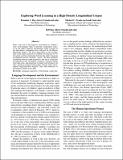Exploring word learning in a high-density longitudinal corpus
Author(s)
Frank, Michael C.; Roy, Brandon C.; Roy, Deb K
DownloadRoy_Exploring Word.pdf (817.2Kb)
OPEN_ACCESS_POLICY
Open Access Policy
Creative Commons Attribution-Noncommercial-Share Alike
Terms of use
Metadata
Show full item recordAbstract
What is the role of the linguistic environment in children’s
early word learning? Here we provide a preliminary analysis
of one child’s linguistic development, using a portion of
the high-density longitudinal data collected for the Human
Speechome Project. We focus particularly on the development
of the child’s productive vocabulary from the age of 9 to
24 months and the relationship between the child’s language
development and the caregivers’ speech. We find significant
correlations between input frequencies and age of acquisition
for individual words. In addition, caregivers’ utterance length,
type-token ratio, and proportion of single-word utterances all
show significant temporal relationships with the child’s development,
suggesting that caregivers “tune” their utterances to
the linguistic ability of the child.
Date issued
2009-07Department
Massachusetts Institute of Technology. Department of Brain and Cognitive Sciences; Massachusetts Institute of Technology. Media Laboratory; Program in Media Arts and Sciences (Massachusetts Institute of Technology)Journal
Proceedings of the Thirty-First Annual Conference of the Cognitive Science Society, CogSci 2009
Publisher
Cognitive Science Society, Inc.
Citation
Roy, Brandon C., Michael C. Frank, and Deb Roy. "Exploring word learning in a high-density longitudinal corpus." in Proceedings of the Thirty-First Annual Conference of the Cognitive Science Society, July 29-August 1, 2009, Vrije Universiteit, Amsterdam, Netherlands.
Version: Author's final manuscript
ISBN
978-0-9768318-5-3